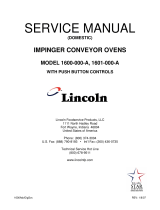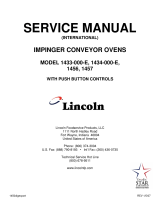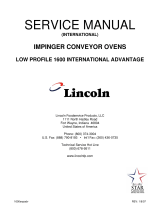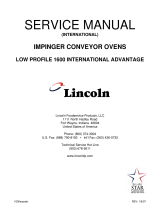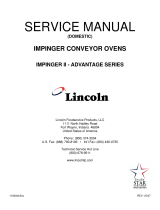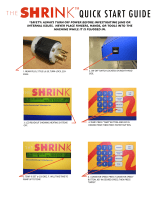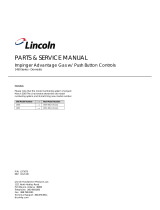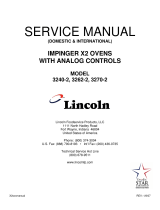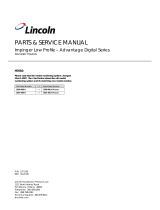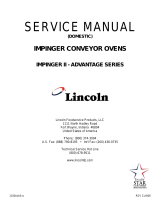Page is loading ...

REV: 5/2/12
Lincoln Foodservice Products, LLC
1111 North Hadley Road
Fort Wayne, Indiana 46804
Telephone: 260.459.8200
Fax: 888.790.8193
Technical Support: 800.678.9511
lincolnfp.com
PARTS & SERVICE MANUAL
Impinger 3270
Impinger 3270 CE

Impinger 3270 Service Manual – Dom & Int’l
2
Table of Contents
MODEL NUMBER KEY............................................................................................................... 3
SEQUENCE OF OPERATION - DOMESTIC .............................................................................. 4
SEQUENCE OF OPERATION - INTERNATIONAL .................................................................... 5
SCHEMATIC DIAGRAM - DOMESTIC ....................................................................................... 6
SCHEMATIC DIAGRAM - INTERNATIONAL ............................................................................. 7
TROUBLESHOOTING GUIDE - DOMESTIC .............................................................................. 8
TROUBLESHOOTING GUIDE - INTERNATIONAL .................................................................. 13
REMOVAL, INSTALLATION & ADJUSTMENTS ...................................................................... 18
OVEN CONTROL – PROGRAMMING...................................................................................... 25
GENERAL VIEW ....................................................................................................................... 27
CONTROL BOX, LEFT SIDE - DOMESTIC .............................................................................. 29
CONTROL BOX, RIGHT SIDE - DOMESTIC ........................................................................... 31
CONTROL BOX, LEFT SIDE - INTERNATIONAL .................................................................... 33
CONTROL BOX, RIGHT SIDE – INTERNATIONAL ................................................................. 35
REAR WALL MOTOR ASSEMBLY ........................................................................................... 37
CONVEYOR, FULL BELT ......................................................................................................... 39
CONVEYOR, SPLIT BELT ........................................................................................................ 41

Impinger 3270 Service Manual – Dom & Int’l
3
MODEL NUMBER KEY
EXAMPLE: 3270-000-N-K1962 or 3270-000-NCE-K1962
32 70 - 0 00 - N - K1962
LANGUAGE CODE TABLE
CODE LANGUAGE COUNTRY CODE LANGUAGE COUNTRY
0 English Dom. & Int. Default N Finnish Finland
B French France/Luxembourg O Restricted ---
C German Germany P Norwegian Norway
D Italian Italy Q English Japan
E Spanish Spain R Swedish Sweden
F English UK/India/Africa/Hungary S English Australia
G Spanish Mexico/Latin America T Mandarin China
H Portuguese Portugal U Restricted ---
I Not Used --- V English Pacific Rim/Korea
J Danish Denmark W English Middle East
K
Dutch &
French
Belgium X Not Used ---
L Dutch Netherlands Y Not Used ---
M Greek Greece Z Not Used ---
FUEL TYPE TABLE
CODE TYPE CODE TYPE
N Natural Gas S 480V 3PH 60Hz
L LP Gas V 120/240V 3PH 60Hz
J 208V 1PH 60Hz B 230V 1PH 50Hz
M 220V 1PH 60Hz D 380/220V 1PH 50Hz
P 240V 1PH 60Hz G 415/240V 1PH 50Hz
R 208V 3PH 60Hz
Panel Setup Code
Fuel Type / Agency Code (i.e. Natural / CE)
Custom Configuration Code (i.e. Solid Belt, General Market)
Oven Platform Size (cooking chamber width)
Oven Platform Size (belt width)
Language Code (i.e. English)

Impinger 3270 Service Manual – Dom & Int’l
4
SEQUENCE OF OPERATION - DOMESTIC
Model Gas Type Voltage Hz. Phase
3270 Natural Gas 120 VAC 60 Hz 1 Phase
3270 LP Gas 120 VAC 60 Hz 1 Phase
POWER SUPPLY
Electrical power to be supplied to the oven by a three conductor cordset.
Voltage from the black conductor to the white conductor to be 120VAC.
- White conductor is Neutral
- Green conductor is Ground
CONTROL BOX
AUTO COOL DOWN
When the temperature in either one of the control boxes reaches 120°F ± 3°F
(49°C ± 1.7°C), the cooling fan thermostats will switch power to the cooling fans.
The thermostats will interrupt power to the cooling fans when the temperature
falls to 100°F ± 3°F (37°C ± 1.7°C).
MAIN FAN CIRCUIT
120VAC is permanently supplied through a 15 amp fuse to the normally open
double pole power switch, to a normally open set of contacts on the main fan
relay and the normally open cooling fan thermostats. Closing the power switch
supplies 120VAC to the coil of the time delay relay. These normally open
contacts now close supplying 120VAC to the time delay which then supplies
120VAC to the main fan relay coil closing the normally open contacts, which then
supplies 120VAC to the main fan motors.
BURNER CIRCUIT
Closing the Oven Power Switch also supplies 120VAC to the burner blower
motors. NOTE: This oven utilizes two (2) complete Burner/Temperature Control
systems. The sequence of operations is the same for each system. 120VAC is
supplied, through the Centrifugal Switch of the Main Fan Motor (this switch
closes when the Main Fan reaches approximately 900 R.P.M.) to the primary of
Ignition Control Transformers. As the Burner Blower reaches approximately
1600 R.P.M., its internal centrifugal switch will close, supplying 24VAC to the
ignition control. The Ignition Control operates on both 24VAC and 120VAC.
When the control is energized by 24VAC, 120VAC is switched to the Hot Surface
Igniter for 45 seconds for Hot Surface Igniter warm up. The igniter glows red,
24VAC is switched to the MV/PV gas valve which opens, and ignition should now
occur. If ignition does not occur in 6 seconds, the control will lock out. To
recycle after lockout, turn off the main oven switch for 45 seconds and then turn
the switch back on.
TEMPERATURE CONTROL
When the Oven Power Switch closes, power is supplied to the Oven Control
Transformers which supply 24VAC to the oven controls (TWO CONTROLS –
one for the left side of oven, one for the right side of oven). The oven control is
set to a desired temperature. Thermocouples will provide varying millivolts to the
oven controllers. The oven controllers supply 3-24VDC to the modulating valve
to maintain desired temperature.
CONVEYOR DRIVE
Line voltage (120VAC) is supplied to the conveyor motor. The conveyor speed is
controlled by an increase or decrease in frequency for the conveyor controller.
Secondary voltage, 24VAC, is supplied to the oven control. Setting the oven
control to the desired time, outputs line voltage, through a reversing switch, to
the conveyor motor.
Speed is monitored via frequency output from the hall effect sensor.
NOTE: The conveyor control uses a hall effect sensor and magnet mounted in the conveyor motor that senses the
motor speed. Any change in motor load (± R.P.M.) is detected by the sensor and the frequency to the motor is
adjusted accordingly.

Impinger 3270 Service Manual – Dom & Int’l
5
SEQUENCE OF OPERATION - INTERNATIONAL
Model Gas Type Voltage Hz. Phase
3270 CE Natural Gas 230 VAC 50 Hz 1 Phase
3270 CE LP Gas 230 VAC 50 Hz 1 Phase
POWER SUPPLY
Electrical power to be supplied to the oven by a three conductor service.
CONTROL BOX
AUTO COOL DOWN
When the temperature in either one of the Control Boxes reaches 49°C ± 1.7°C,
(120°F ± 3°F) the Cooling Fan Thermostats will switch power to the Cooling
Fans. The thermostats will interrupt power to the Cooling Fans when the
temperature falls to 37°C ± 1.7°C (100°F ± 3°F).
MAIN FAN CIRCUIT
Power is permanently supplied through a 10 amp fuse, through the normally
closed emergency stop button, to the normally open double pole power switch, to
a normally open set of contacts on the main fan relay and the normally open
cooling fan thermostats. Closing the power switch supplies line voltage to the
coil of the time delay relay. These normally open contacts now close enabling
the time delay which then supplies line voltage to the main fan relay. As these
normally open contacts close, line voltage is supplied to the main fan motors.
BURNER CIRCUIT
Closing the oven power switch supplies line voltage, through the main fan air
pressure switch, through the normally closed oven cavity hi-limit thermostat, to
the ignition control. The combustion motor is now energized; the normally open
combustion air pressure switch closes upon sensing air. After a prepurge period
between 30 and 60 seconds, the spark and main gas valve are energized.
Ignition should now occur.
TEMPERATURE CONTROL
When the Oven Power Switch closes, power is supplied to the Oven Control
transformers which supply 24 VAC to the Oven Controls (TWO CONTROLS one
for the oven’s left side, one for the oven’s right side). The Oven Control is set to a
desired temperature. Thermocouples will provide varying millivolts to the Oven
Controllers. The Oven Controllers supply 3-24 VDC to the modulating valve to
maintain desired temperature.
CONVEYOR DRIVE
Line voltage is supplied to the conveyor motor. The Conveyor speed is controlled
by an increase or decrease in frequency from the Conveyor Controller.
Secondary voltage, 24VAC, is supplied to the oven control. Setting the oven
control to the desired time, outputs line voltage, through a reversing switch, to
the conveyor motor.
Speed is monitored via a frequency output from the hall effect sensor.
NOTE: The conveyor control uses a hall effect sensor and magnet mounted in the conveyor motor that senses the
motor speed. Any change in motor load (± R.P.M.) is detected by the sensor and the frequency to the motor is
adjusted accordingly.

Impinger 3270 Service Manual – Dom & Int’l
6
SCHEMATIC DIAGRAM - DOMESTIC
MODEL 3270 120V 60HZ 1PH NATURAL or LP GAS

Impinger 3270 Service Manual – Dom & Int’l
7
SCHEMATIC DIAGRAM - INTERNATIONAL
MODEL 3270 CE 230V 50HZ 1PH NATURAL or LP GAS

Impinger 3270 Service Manual – Dom & Int’l
8
TROUBLESHOOTING GUIDE - DOMESTIC
Model Number Gas Type Voltage Hz. Phase
3270 Natural Gas 120 VAC 60 Hz 1 Phase
3270 LP Gas 120 VAC 60 Hz 1 Phase
SYMPTOM
POSSIBLE CAUSE
EVALUATION
Oven fan will not run
Incoming Power Supply
Check breakers, reset if required. Check power plug to be
sure it is firmly in receptacle. Measure the incoming power.
Call power company if needed.
Fuse, 15 Amp
Check, replace if necessary.
Fuse Holder
Check, replace if necessary.
Main Oven Switch
Check continuity between switch terminals. Replace if
necessary.
Time Delay Relay
Check for 120 VAC to the relay coil. If voltage is not
present, trace wiring back to the oven power switch. If
voltage is present, check to insure contacts are closing.
Time Delay
120 VAC is permanently supplied to the time delay. If no
voltage is present, trace wiring back to fuse and incoming
power. Neutral side of time delay coil is switched by the
time delay relay. When the time delay is enabled, it
supplies 120 VAC to coil of main fan relay.
Main Fan Relay
Check for 120 VAC to main fan relay coil. If no voltage is
present, trace back to time delay. If 120 VAC is supplied to
main fan relay coil, ensure the contacts of main fan relay
are closing by checking for 120 VAC on terminals #4 to a
neutral and #8 to a neutral (these are the terminal numbers
on the main fan relay). If contacts are not closing, replace
the relay. Each terminal supplies a main fan motor with
120 VAC.
Main Fan Motor
Check for 120 VAC at motor. If voltage is present and
motor doesn’t turn, WITH POWER OFF check for opens,
shorts, or grounds. Turn fan blade to check for locked
rotor. Replace as needed.
Capacitor
WARNING: Capacitor has a stored charge, discharge
before testing. Check for shorts or grounds, replace as
needed. Inspect for any visible damage. If the top of the
capacitor appears to be swollen, replace capacitor.
No control box cooling
Incoming Power
Check main circuit breakers and reset, if required. Call
power company if needed.
Fuse, 15 Amp
Check, replace if necessary.
Fuse Holder
Check, replace if necessary.
Main Oven Switch
Check continuity between switch terminals. Replace if
necessary.
Cooling Fan(s)
120 VAC should now be at the fan motor. If voltage is
present and motor doesn’t turn, WITH POWER OFF, check

Impinger 3270 Service Manual – Dom & Int’l
9
motors for shorts or opens. Check for locked rotor.
Replace if necessary.
No automatic control box
cooling
Incoming Power Supply
Check circuit breakers. Reset if required. Call power
company if needed.
Fuse, 15 Amp
Check, replace if necessary.
Fuse Holder
Check, replace if necessary.
Cooling Fan Thermostat
Check the cooling fan thermostat. (Thermostat closes at
120°F and opens at 100°F.) With the cooling fan
thermostat preheated, check for continuity. If switch is
open, replace.
Cooling Fan(s)
120 VAC should be at the motor. If voltage is present,
WITH POWER OFF, check for locked rotor. Check motor
for shorts, opens, or grounds.
Oven will not heat
Gas Supply
Check manual gas valves and flexible gas line connection.
Also check for adequate gas supply.
NOTE: Natural Gas supply to oven – min. 7 in. W.C.
LP Gas supply to oven – min. 11 in. W.C.
Main Fan
If not operating, refer to “oven fan will not run”.
NOTE: These ovens utilize 2 complete burner/temperature control systems. Each system will follow the same
troubleshooting sequence.
Oven will not heat
Centrifugal Switch of
Main Fan Motor
Check for 120 VAC supplied to the centrifugal switch. If
voltage is not present, trace the wiring back to the oven
power switch. Check for 120 VAC out of the centrifugal
switch. If voltage is supplied to the centrifugal switch, and
motor is running but there is no voltage out of the
centrifugal switch, replace the fan motor.
(NOTE: See Schematic Diagram of proper wire numbers
on motors.)
Burner Blower Motor
If no 120 VAC to blower motor, trace wiring back to oven
power switch. Check for 120 VAC supply to the burner
blower motor, if 120 VAC is present and motor does not
turn, replace the motor.
Burner Transformer
Check for 120 VAC to primary of the 24 VAC ignition
control transformer. If voltage is not present, trace wiring
back to the centrifugal switch of main fan motor. If voltage
is present, check for 24 VAC at the secondary. If no
secondary voltage is present, replace the transformer.
Centrifugal Switch of
Burner Blower Motor
Check for 24 VAC supply to the centrifugal switch of burner
blower motor (see Schematic for proper wire numbers). If
no voltage is present, trace wiring back to the transformer.
If voltage is present, check for 24 VAC at the output of the
centrifugal switch. If there is no output and the burner
blower motor is running, replace the burner blower motor.
Ignition Control
Check for 24 VAC supply to the ignition control at terminals
marked 24V and 24V. If voltage is not present, trace wiring
back to the centrifugal switch of burner blower motor.
Check for 120VAC supply to the ignition control at

Impinger 3270 Service Manual – Dom & Int’l
10
terminals L1 and L2. If no voltage is present, trace wiring
back to oven power switch. If the above checks are okay,
proceed. When 24 VAC is applied, the ignition control
should switch 120VAC to the hot surface igniter for 45
seconds. Check across the (2) terminals marked HIS. If
no voltage is present, replace the ignition control.
Oven will not heat
(continued)
Hot Surface Igniter
(Located inside Burner
Assembly)
If 120VAC is present at HSI terminals, visually check to
see that the hot surface igniter is heating (igniter may be
viewed through port glass in end of burner tube). The
igniter should glow bright red. Check all connections to be
sure they are tight. If the igniter does not heat, replace.
Ignition Control
After 45 seconds of hot surface igniter pre-heat, the ignition
control will switch 24 VAC to the gas control valves for 6
seconds. Check for 24 VAC output from the ignition
control and across terminals marked “valve” and “valve”. If
no voltage is present, replace the ignition control.
NOTE: The ignition control contains a safety lockout
circuit. If a flame is not detected within 6 seconds after the
gas control valve is energized, the ignition control will
lockout. To reset, turn the power switch “off”, wait 45
seconds and switch the system “on” to retry ignition.
Gas Control Valves
Check for 24 VAC supplied to the pilot/main gas valves
(dual valve). If voltage is present, the valves should open.
Check the output gas pressure at the pressure tap located
on the burner manifold. Gas pressure should measure
approximately .6 in. W.C. If there is no gas pressure and
the voltage is supplied to valves, check piping for
obstructions.
Flame will not stay on
Hot Surface Igniter
The ignition control will keep the gas control valves
energized for 6 seconds. At the end of 6 seconds the hot
surface igniter must sense a flame or the ignition control
will go to into lockout. (The ignition control requires a
minimum of 0.8 micro-amps D.C.) If you detect a flame but
only for the 6 second trial, check the flame sensing
operation. Connect a digital multimeter (capable of
measuring D.C. micro-amps) between the “ground”
terminal on the ignition control and the ground lead.
NOTE: This is a current measurement and the meter must
be connected in series. NOTE: The D.C. micro-amp test
must be conducted in series. NOTE: The D.C. micro amp
test must be conducted with the oven in low flame (bypass)
operation. Set the temperature control to its lowest setting.
Power Supply
If there is sufficient micro-amp current and the 120VAC
polarity is correct but the flame will not stay lit, check for
proper ground connection for the ignition control. If ground
is good, replace the ignition control.
NOTE: Flame should be lit at this time.
Low flame is on but no
main flame
Oven Control
Adjust temperature to maximum setting and check for 3-24
VDC at terminals J2-6 & J2-9 on oven control. If 3-24 VDC
is present and unit is not heating, refer to “Modulating
Valve” for next check. If 3-24 VDC is not present, proceed.
Thermocouple Probe
WITH POWER ON AND THERMOCOUPLE LEADS

Impinger 3270 Service Manual – Dom & Int’l
11
ATTACHED TO THE TEMPERATURE CONTROL
BOARD:
Measure the D.C. millivolt output of these leads. Refer to
thermocouple chart in “Removal and Installation” section of
service manual for proper readings. If these readings are
not achieved, replace the thermocouple. If these readings
are achieved with temperature at maximum setting, replace
the oven control.
Low flame is on but no
main flame (continued)
Modulating Valve
With temperature at maximum setting, check for 3-24 VDC
at the modulating valve. If no voltage is present, trace
wiring back to the oven control terminals J2-6 & J2-9. If
voltage is present, check the output gas pressure at the
pressure tap located on the burner manifold. If voltage is
present and gas pressure is not exceeding .6 in. W.C. at
the burner manifold, replace modulating valve.
Intermittent heating
Thermal/Overload of Main
Fan and Burner Blower
Motors
The main fan motors and the burner blower motors are
equipped with internal thermal protection and will cease to
operate if overheating occurs. As the motors overheat and
then cool, this will cause the units to cycle on and off
intermittently. Improper ventilation or improper
maintenance may cause this. Also, most of the problems
listed under “oven will not heat” can cause intermittent
failure.
Conveyor will not run
Power Supply
Check incoming voltage supply at line 1 to neutral. There
should be a voltage reading of 120VAC. If not present,
check breakers.
15 Amp Fuse
Check and/or replace.
Fuse Holder
Check and/or replace.
Main Fan Switch
Check continuity between switch terminals.
Oven Control
Transformer
Check for supply voltage to primary of transformer. If no
voltage is present, trace wiring back to the main oven
switch. If voltage is present, check for 24VAC at
transformer secondary. If there is primary voltage but no
secondary voltage, replace transformer. If secondary
voltage is present, proceed.
Switch, Conveyor
Reversing
Check for continuity between switch terminals. Replace
switch as needed.
Conveyor Motor
Check for supply voltage to the motor. If no voltage is
present, trace wiring back to the reversing switch. If no
voltage at switch, replace conveyor control. If voltage is
present, check motor windings for opens or shorts.
WITH POWER OFF: Check the motor windings as follows:
Grey to Black – 38 ohm approx.
Grey to Brown – 38 ohm approx.
Brown to Black – 75 ohm approx.
If any of the above fail, replace motor.
Conveyor Motor
Capacitor
Check for shorts or grounds. Replace capacitor as
needed.
WARNING: Capacitor has a stored charge. Discharge
before testing!

Impinger 3270 Service Manual – Dom & Int’l
12
Conveyor will not run
(continued)
Conveyor Check for any mechanical problems in the conveyor
assembly. Check for damaged or torn belting. Check
conveyor shaft bearings for damage or excessive wear.
Repair or replace conveyor components as needed.
Oven Control
Check output voltage from oven control to hall effect sensor
(sensor is located in conveyor motor). Measure voltage at
the motor connector, red wire and yellow wire. Voltage
should be approx. 10VDC. If no voltage is present, trace
wiring back to the oven control. If there is no voltage
output present at the oven control, replace the oven
control.
Conveyor runs but no
speed control
Motor, Conveyor
If there is voltage supplied to the hall effect sensor, check
for frequency output from the hall effect sensor. Measure
frequency across the yellow and white wires at the motor
connector. Frequency readings should be between 25 –
500 Hz. If these readings are not achieved, replace the
conveyor motor. If these readings are achieved, proceed.
Oven Control
If the hall effect sensor readings are correct but there is no
speed indicated on the display, replace the oven control.

Impinger 3270 Service Manual – Dom & Int’l
13
TROUBLESHOOTING GUIDE - INTERNATIONAL
Model Number Gas Type Voltage Hz. Phase
3270 CE Natural Gas 230 VAC 50 Hz 1 Phase
3270 CE LP Gas 230 VAC 50 Hz 1 Phase
SYMPTOM
POSSIBLE CAUSE
EVALUATION
Oven fan will not run
Incoming Power Supply
Check breakers, reset if required. Check power plug to be
sure it is firmly in receptacle. Measure the incoming power.
Call power company if needed.
Fuse, 10 Amp
Check, replace if necessary.
Fuse Holder
Check, replace if necessary.
Emergency Stop Button
This is a normally closed switch. Be sure button is re-set.
Check continuity between switch terminals. If switch is
open, replace Emergency stop button.
Main Oven Switch
Check continuity between terminals. Replace if necessary.
Time Delay Relay
Check for line voltage to the relay coil. If voltage is not
present, trace wiring back to the oven power switch. If
voltage is present, check to insure contacts are closing.
Replace as needed.
Time Delay
Line voltage is permanently supplied to terminal #1 of the
time delay. If no voltage present trace wiring back to fuse
and incoming power. Neutral side of time delay coil is
switched by the time delay relay. When the time delay is
enabled, line voltage is supplied to coil of main fan relay.
Main Fan Relay
Check for line voltage to main fan relay coil. If no voltage is
present, trace wiring back to time delay. If line voltage is
supplied to main fan relay coil, ensure the contacts of main
fan relay are closing by checking for output voltage from
relay contacts. If contacts are not closing, replace relay.
Each terminal supplies a main fan motor with line voltage.
Main Fan Motor
Check for line voltage at motor. If voltage is present and
motor doesn’t turn, WITH POWER OFF, check for opens,
shorts, or grounds. Turn fan blade to check for locked
rotor. Replace as needed.
Capacitor
WARNING: Capacitor has a stored charge, discharge
before testing. Check for shorts or grounds, replace as
needed. Inspect for any visible damage. If the top of the
capacitor appears to be swollen, replace capacitor.
No control box cooling
Incoming Power
Check main circuit breakers and reset, if required. Call
power company if needed.
Fuse, 10 Amp
Check, replace if necessary.
Fuse Holder
Check, replace if necessary.
Main Oven Switch
Check continuity between terminals. Replace if necessary.
Cooling Fan(s)
Line voltage should now be at the fan motor. If voltage is

Impinger 3270 Service Manual – Dom & Int’l
14
present and motor doesn’t turn, WITH POWER OFF, check
motors for shorts or opens. Check for locked rotor.
Replace if necessary.
No automatic control box
cooling
Incoming Power Supply
Check circuit breakers. Reset if required. Call power
company if needed.
Fuse, 10 Amp
Check, replace if necessary.
Fuse Holder
Check, replace if necessary.
Cooling Fan Thermostat
Check the cooling fan thermostat. Thermostat closes at
49°C (120°F) and opens at 37°C (100°F). With the cooling
fan thermostat preheated, check for continuity. If switch is
open, replace.
Cooling Fan(s)
Line voltage should be at the motor. If voltage is present,
WITH POWER OFF, check for locked rotor. Check motor
for shorts, opens, or grounds.
Oven will not heat
Gas Supply
Check manual gas valves and flexible gas line connection.
Also check for adequate gas supply.
NOTE: NAT Gas supply to oven – min. 7” W.C. (1.74kPa)
LP Gas supply to oven – min. 11” W.C. (2.73kPa)
Main Fan
If not operating, refer to “oven fan will not run”.
NOTE: These ovens utilize 2 complete burner/temperature control systems. Each system will follow the same
troubleshooting sequence.
Oven will not heat
Air Pressure Switch of
Main Fan Motor
Check air pressure switch terminals for supply voltage to
terminals COM and NO. If voltage is present on one side
only, check for air tube blockage or misalignment. If these
are okay, adjust air pressure switch or replace switch as
needed.
Oven Cavity Hi-Limit
Thermostat
Terminals are normally closed, opens at 350C (660F). If
open, reset and test oven for proper operation. If
thermostat will not hold for maximum temperature, and
oven is not exceeding control setting, check for proper
location of the capillary bulb in its spring holder. If above
checks are okay. Replace hi-limit thermostat.
Ignition Control
Check for supply voltage to ignition control at terminal #1
and neutral. If no voltage is present, trace wiring back to hi-
limit thermostat. If voltage is present, check for supply
voltage to burner blower motor at terminal #8 and neutral.
If no voltage is present, wait 30 seconds reset ignition
control, and re-try. If the above fails, replace ignition
control.
Burner Reset Switch
Switch is normally open. Check to see that the switch
closes when reset button is pushed. Replace as needed.
Burner Blower Motor
Check for supply voltage to burner blower motor. If no
voltage is present, trace wiring back to ignition control.
WITH POWER OFF: Turn blower wheel to check for locked
rotor.
If supply voltage is present, and motor does not run,
replace burner blower motor.

Impinger 3270 Service Manual – Dom & Int’l
15
Oven will not heat
(continued)
Air Pressure Switch of
Burner Blower Motor
Check for air pressure switch to be switching from “NC” to
“NO”. Check for air tube blockage or misalignment. Adjust
air pressure switch. If the above fails, replace air pressure
switch.
Ignition Control
A pre-purge time of 30 to 60 seconds occurs after burner
blower motor starts. Check for high voltage spark output
from the ignition control. If there is no high voltage spark
output, check the reset button for the ignition control. If
there is still no high voltage output, replace the ignition
control.
Spark Cable
Check spark cable for loose terminations. Verify resistance
to be between 514Ω and 1068Ω. Replace if necessary.
Igniter / Sensor
Assembly (Located
inside Burner Assembly)
Check for visible damage to the igniter/sensor assembly. If
there is visible damage to the igniter/sensor assembly,
replace. Check the spark gap (.096” 2.44mm). If there is no
visible damage to the components, and no spark, replace
the igniter/sensor assembly. Also check for frayed or
damaged wires in burner tube. Replace components as
needed.
Ignition Control
Gas valve should open as the ignition control generates
the high voltage spark. Check for supply voltage to pilot
valve at terminal #5 and neutral. If no voltage is present,
check reset button for the ignition control. If there is still no
voltage to the pilot valve, replace ignition control.
Gas Control Valves
Check for supply voltage to pilot valve at terminal #5 to
neutral, if there is no voltage, trace wiring back to ignition
control. If there is supply voltage, connect a manometer to
the pressure tap fitting in the gas line. If there is voltage to
the pilot valve, but there is no gas pressure, replace gas
valve.
Flame will not stay on
Flame Sensor
To check flame sensor operation, connect a digital
multimeter (capable of measuring D.C. microamps)
between the flame sensor wire and flame sensor
connection on the ignition control. Flame sensor current is
to be 0.7 microamps, minimum. If these readings are not
achieved, replace igniter/sensor assembly. Also check for
any type of damage to flame sensor wire and connections.
NOTE: The D.C. microamp test must be conducted with
the oven in low flame (bypass) operation.
Power Supply
Set the temperature to the lowest temperature setting. If
there is sufficient microamp current, but the flame will not
stay lit, check for proper polarity of the power supply.
Ignition Control
If there is sufficient microamp current, and there is proper
polarity of the power supply, but the burner will not stay lit,
check the reset button for the ignition control. If the above
test is okay, replace the ignition control.
NOTE: Flame should be lit at this time.

Impinger 3270 Service Manual – Dom & Int’l
16
Low flame is on but no
main flame
Control Transformer
Check for supply voltage to primary of control transformer.
If no voltage is present, trace wiring back to EMI filter. If
voltage is present, check for 24VAC at transformer
secondary. If there is primary voltage, but no secondary
voltage, replace control transformer.
Oven Control
Adjust temperature to maximum setting and check for 3-24
VDC at terminals J2-6 & J2-9 on oven control. If 3-24 VDC
is present and unit is not heating, refer to "Modulating
Valve" for next check. If 3-24 VDC is not present, proceed.
Thermocouple Probe
WITH POWER ON AND THERMOCOUPLE LEADS
ATTACHED TO THE TEMPERATURE CONTROL
BOARD:
Measure the D.C. millivolt output of these leads. Refer to
thermocouple chart in “Removal and Installation” section of
service manual for proper readings. If these readings are
not achieved, replace the thermocouple. If these readings
are achieved with temperature at maximum setting, replace
the oven control.
Modulating Valve
With temperature at maximum setting, check for 3-24 VDC
at the modulating valve. If no voltage is present, trace
wiring back to the oven control terminals J2-6 & J2-9. If
voltage is present, check the output gas pressure at the
pressure tap located on the burner manifold. If voltage is
present and gas pressure is not exceeding .6 in. W.C. at
the burner manifold, replace modulating valve.
Intermittent heating
Thermal/Overload of Main
Fan and Burner Blower
Motors
The main fan motors and the burner blower motors are
equipped with internal thermal protection and will cease to
operate if overheating occurs. As the motors overheat and
then cool, this will cause the units to cycle on and off
intermittently. Improper ventilation or improper
maintenance may cause this. Also, most of the problems
listed under “Oven will not heat” can cause intermittent
failure.
Conveyor will not run
Power Supply
Check incoming voltage supply at line 1 to neutral. There
should be a line voltage reading. If not present, check
breakers.
10 Amp Fuse
Check and/or replace.
Fuse Holder
Check and/or replace.
Main Fan Switch
Check continuity between switch terminals.
Oven Control
Transformer
Check for supply voltage to primary of transformer. If no
voltage is present, trace wiring back to the main oven
switch. If voltage is present, check for 24VAC at
transformer secondary. If there is primary voltage but no
secondary voltage, replace transformer. If secondary
voltage is present, proceed.
Switch, Conveyor
Reversing
Check for continuity between switch terminals. Replace
switch as needed.
Conveyor Motor
Check for supply voltage to the motor. If no voltage is
present, trace wiring back to the reversing switch. If no

Impinger 3270 Service Manual – Dom & Int’l
17
voltage at switch, replace conveyor control. If voltage is
present, check motor windings for opens or shorts.
WITH POWER OFF: Check the motor windings as follows:
Grey to Black – 116 ohm approx.
Grey to Brown – 116 ohm approx.
Brown to Black – 230 ohm approx.
If any of the above fail, replace motor.
Conveyor will not run
(continued)
Conveyor Motor
Capacitor
Check for shorts or grounds. Replace capacitor as
needed.
WARNING: Capacitor has a stored charge. Discharge
before testing!
Conveyor
Check for any mechanical problems in the conveyor
assembly. Check for damaged or torn belting. Check
conveyor shaft bearings for damage or excessive wear.
Repair or replace conveyor components as needed.
Oven Control
Check output voltage from oven control to hall effect sensor
(sensor is located in conveyor motor). Measure voltage at
the motor connector, red wire and yellow wire. Voltage
should be approx. 10VDC. If no voltage is present, trace
wiring back to the oven control. If there is no voltage
output present at the oven control, replace the oven
control.
Conveyor runs but no
speed control
Motor, Conveyor
If there is voltage supplied to the hall effect sensor, check
for frequency output from the hall effect sensor. Measure
frequency across the yellow and white wires at the motor
connector. Frequency readings should be between 25 –
500 Hz. If these readings are not achieved, replace the
conveyor motor. If these readings are achieved, proceed.
Oven Control
If the hall effect sensor readings are correct but there is no
speed indicated on the display, replace the oven control.

Impinger 3270 Service Manual – Dom & Int’l
18
REMOVAL, INSTALLATION & ADJUSTMENTS
BURNER CONTROL – HONEYWELL – REPLACEMENT – DOMESTIC ONLY
WITH POWER OFF:
A. Remove appropriate control box cover.
B. Remove wires from control while noting wire number and location for reassembly.
C. Remove two (2) screws from control and replace.
D. Reassemble in reverse order and check system operation.
IGNITION CONTROL – REPLACEMENT – INTERNATIONAL ONLY
WITH POWER OFF:
A. Remove appropriate control box cover.
B. Remove wires from control while noting wire number and location for reassembly.
C. Remove one (1) mounting screw and remove ignition control from gas valve.
D. Reassemble in reverse order and check system operation.
BURNER BLOWER MOTOR – REPLACEMENT
WITH POWER OFF:
A. Remove appropriate control box cover.
B. Unplug motor connector.
C. Remove three (3) screws from blower tube at burner housing.
D. Remove air shutter assembly from old motor for installation on new motor assembly.
E. Reassemble in reverse order and check system operation.
NOTE: CHECK AIR SHUTTER ADJUSTMENT. It should be set at ½ open.
HOT SURFACE IGNITOR – REPLACEMENT – DOMESTIC ONLY
WITH POWER OFF:
A. Remove appropriate control box cover.
B. Disconnect gas line at union.
C. Remove four (4) nuts from burner orifice bracket.
D. Remove tube for bypass flame.
E. Unplug connector at burner housing.
F. Remove three (3) screws from burner housing end cap and remove hot surface igniter and burner tube
assembly.
G. Replace igniter assembly and reassemble in reverse order.
H. CAUTION: USE CARE NOT TO DAMAGE NEW IGNITER. ALSO, NEVER TOUCH IGNITER WITH BARE
HANDS.
NOTE: Check all gas line fittings for leaks. Make sure connector is seated properly.
IGNITOR SENSOR – REPLACEMENT – INTERNATIONAL ONLY
WITH POWER OFF:
A. Remove appropriate control box cover.
B. Remove gas valve assembly (see gas valve).
C. Remove screws from burner tube and pull burner assembly out.
D. Remove wire connectors from igniter sensor assembly.
E. Remove screws from mounting bracket and remove assembly.
F. Reassemble in reverse order and check system operation.
NOTE: After installation, check all gas line fittings for leaks.
!
WARNING
:
BEFORE REMOVING OR INSTALLING ANY COMPONENT IN THE
IMPINGER OVEN, BE SURE TO DISCONNECT ALL ELECTRICAL POWER
AND SHUT OFF GAS SUPPLY.

Impinger 3270 Service Manual – Dom & Int’l
19
CONVEYOR DRIVE MOTOR – REPLACEMENT
WITH POWER OFF:
A. Shut off power at main breaker.
B. Remove drive chain and drive sprocket from conveyor motor.
C. Remove control panel top and front cover.
D. Disconnect motor connector (6 pin connector).
E. Remove 4 mounting bolts and remove conveyor motor.
F. Reassemble in reverse order.
REVERSING SWITCH – REPLACEMENT
WITH POWER OFF:
A. Shut power off at main breaker.
B. Remove control panel top.
C. Disconnect wiring from reversing switch and mark all wiring for reassembly.
(See schematic diagram for wire numbers.)
D. Remove mounting nut from reversing switch and remove reversing switch and reversing switch cover.
E. Reassemble in reverse order.
REVERSING CONVEYOR DIRECTION
A. Shut off power at oven switch.
B. Set reversing switch in the other position.
C. Turn oven “on” and check for proper operation.
BURNER RESET SWITCH – REPLACEMENT – INTERNATIONAL ONLY
WITH POWER OFF:
A. Remove appropriate control box cover.
B. Disconnect wires from ignition control (see ignition control). Note wire number and location for reassembly.
C. Pull off black operating knob and remove hex mounting nut.
D. Reassemble in reverse order.
BURNER ALARM – REPLACEMENT – INTERNATIONAL ONLY
WITH POWER OFF:
A. Remove appropriate control box cover.
B. Remove 2 wires from alarm. Note wire number and location for reassembly.
C. Remove retainer cover from alarm and remove assembly from control box.
D. Reassemble in reverse order and check system operation.
AIR PRESURE SWITCH – REPLACEMENT – INTERNATIONAL ONLY
WITH POWER OFF:
A. Remove appropriate control box cover.
B. Disconnect wires from switch making note of wire number and location for reinstallation.
C. Remove air tube from switch assembly.
D. Remove mounting screws to remove air pressure switch.
E. Reassemble in reverse order. Make sure air tube is not blocked or misaligned.
To adjust air pressure switch, remove cover from the switch to expose adjusting screw. To increase
sensitivity, turn screw counter-clockwise. To decrease sensitivity, turn screw clockwise. Check for
proper line voltage switching from N.C. to N.O. as the air pressure switch closes.
FUSEHOLDER – REPLACEMENT
WITH POWER OFF:
A. Remove appropriate control box cover.
B. Remove two (2) wires, note wire number and location.
C. Remove mounting nut on back side of fuse holder and push out.
D. Reinstall in reverse order and check system operation.

Impinger 3270 Service Manual – Dom & Int’l
20
BURNER CONTROL GAS VALVE (DUAL VALVE) – REPLACEMENT – DOMESTIC ONLY
WITH POWER OFF:
A. Remove appropriate control box cover.
B. Remove incoming gas line.
C. Remove screws from incoming nipple mounting bracket.
D. Remove incoming nipple.
E. Remove bypass tube assembly.
F. Disconnect pipe union.
G. Disconnect wiring from control valve (four [4] push-on connectors). Disconnect wiring from modulating
valve (2 wires) making note of wire numbers and location for reinstallation.
H. Remove both valves. Replace control valve (valves are connected by a ½ inch pipe nipple).
I. Reassemble in reverse order and check system operation. Set manifold pressure on gas valve. Pressure
should be 3.5 in. W.C. Nat., 10 in. W.C. L.P. on a cool oven heating up on full flame.
NOTE: INLET GAS PRESSURE MUST BE A MINIMUM OF 7 IN. W.C. NATURAL AND 11 IN. W.C. L.P.
After installation, check all gas line fittings for leaks.
FRONT VIEW
MANIFOLD ADJUSTMENT
SCREW LOCATED UNDER
COVER SCREW
TOP VIEW
PILOT
LINE
CONNECTION
MANIFOLD PRESSURE
ADJUSTMENT CONNECTION
MANIFOLD ADJUSTMENT
SCREW LOCATED UNDER
COVER SCREW
IGNITION CONTROL GAS VALVE (DUAL VALVE) – REPLACEMENT – INTERNATIONAL ONLY
WITH POWER OFF:
A. Remove appropriate control box cover.
B. Remove incoming gas line.
C. Remove screws from incoming nipple mounting bracket.
D. Remove incoming nipple.
E. Remove wiring from ignition control (mounted on gas valve). Mark all wiring for reassembly.
F. Remove gas valve and piping assembly.
G. Remove piping from gas valve.
H. Reassemble in reverse order and check system operation. Set manifold pressure on gas valve. Pressure
should be 3.5 in. W.C. Nat., 10 in. W.C. L.P. on a cool oven heating up on full flame.
NOTE: INLET GAS PRESSURE MUST BE A MINIMUM OF 7 IN. W.C. NATURAL AND 11 IN. W.C. L.P.
After installation, check all gas line fittings for leaks.
/
